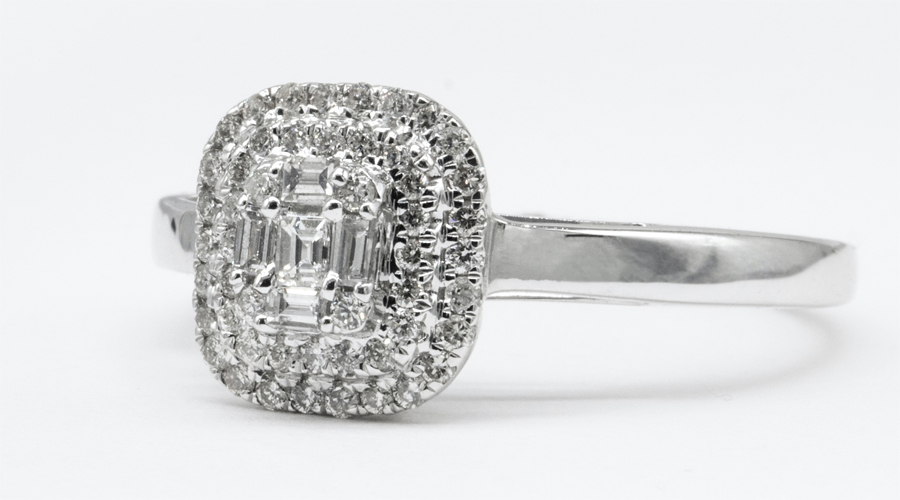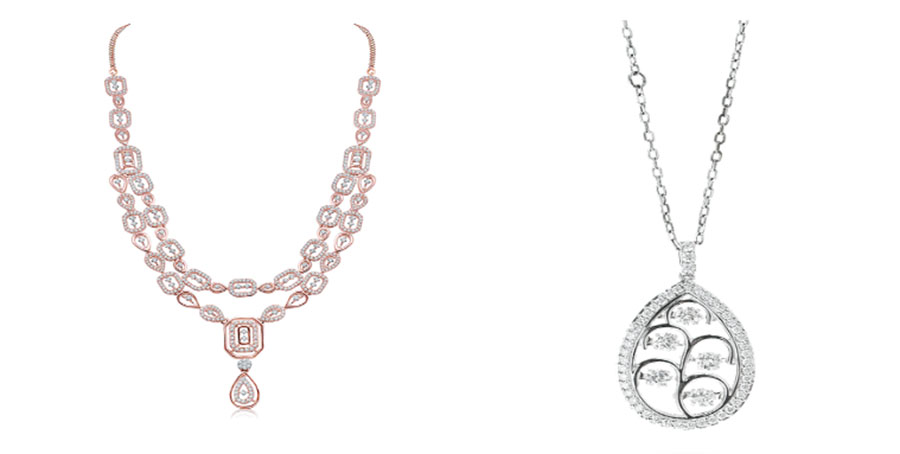White gold is a term commonly used in several contexts, each with its own meaning. It can refer to a type of metal, a valuable item, or a nickname for a specific item. Likewise, white gold is a metal known for its exquisite beauty and strength, and white gold has become a great alternative to traditional yellow gold. Let’s explore these different meanings in this comprehensive guide to white gold:
Table of Content
- What is White Gold?
- The Origins of White Gold
- Components and Purity
- Various White Gold Types
- Caring for White Gold Jewelry
- Properties and Durability
- Price and Affordability
- Conclusion
- Frequently Asked Questions
What is White Gold?
The recognizable pure yellow gold that makes up white gold is combined with other metals to give it the distinctive white luster for which it is known. This turns gold into a truly unique shade. White gold initially resembles platinum, a naturally white metal in appearance. White gold usually contains 75% gold, 25% nickel, and 25% zinc. If it has an 18-karat stamp, it will be 75 percent pure gold.
The Origins of White Gold
The history of white gold jewelry is extensive and fascinating, spanning numerous centuries. The development of white gold dates back to the early 19th century, when jewelers were looking for a substitute for conventional yellow gold. The demand for silver-like jewelry grew then, but pure silver wasn’t ideal for elaborate designs because it was easily tarnished and fragile.
Jewelers started looking at new alloys as a result. The invention of white gold was a breakthrough at the beginning of the 20th century. Jewelers realized they could obtain a lovely white color by fusing pure gold with other metals like palladium, nickel, or silver. These alloys improved the strength and longevity of the jewelry, giving it a brilliant luster akin to silver’s.
Cotton is referred to as “white gold” in the textile industry since it is a plant-based fiber that has been a crucial natural resource since the dawn of numerous civilizations. Sometimes, the name “guano” is also used to refer to the prized white deposits of seabird feces, eggshells, and carcasses found in particular areas and previously employed as a source of fertilizer.
Components and Purity
“white gold” refers to an alloy made of pure gold and other metals like palladium, silver, nickel, or zinc. White gold typically takes on a silvery-white color from this combination, which is common in contemporary jewelry.
The amount of gold in white gold depends on its karat. A higher karat denotes a higher concentration of gold. For instance, 14-karat white gold contains 58.3% gold, while 18-karat white gold has a 75% pure gold content. The remaining portion comprises additional metals that increase the alloy’s longevity and strength.
Various White Gold Types
A mixture of white or silver-looking metals and gold is known as “white gold.” White gold comes in different varieties. White gold is usually made from an alloy of gold, silver, and platinum, occasionally with nickel or zinc. Among these, 14K and 18K are the most popular. The purity of gold is measured by its carat weight. It is essential to understand that as the karat number decreases, so does the amount of gold.
Numerous shades are available for gold, including the well-known yellow gold, rose gold, and red gold. Although white gold is distinguished by its distinctive silver-tone appearance, these colors are obtained by adding different metals to their alloys. Gold is combined with copper and silver to make yellow gold, while copper and gold are used to make rose gold. The red color of red gold is produced by adding additional copper.
Caring for White Gold Jewelry
Many jewelry items, such as wedding bands and engagement rings, are made of white gold. You must follow the correct cleaning and maintenance procedures to keep your white gold jewelry looking beautiful and lasting long.
Cleaning is a crucial part of white gold jewelry maintenance. To remove residue, grease, and dirt, frequently wipe your piece with a soft, lint-free cloth. Proper storage is a critical element in sustaining your white gold jewelry. Keep your accessories in an excellent, dry location from direct sunlight when not in use. To guard against dings and damage from other jewelry, store the jewelry in a soft cloth pouch or a separate area of your jewelry box. These tips can help you keep your white gold jewelry looking beautiful and lasting many years.
Properties and Durability
Popular and adaptable, white gold is used in many products, such as jewelry and timepieces. Copper, palladium, and silver are the most common metals to make these alloys. This combination retains the lustrous luster of gold, increasing its strength and longevity. One of the key elements influencing the popularity of white gold is its likeness to platinum, but at a more affordable price.
Silver and palladium are added to the alloy to increase its strength and hardness, giving it a beautiful white color. White gold is sometimes yellowish because it is not as white as platinum. Depending on the purity, white gold is available in several carats, such as 10k, 14k, and 18k. The more gold the alloy contains, the higher the carat. White gold is desirable for many uses due to its qualities and durability, especially in jewelry. When buying white gold items, it is essential to be aware of any possible disadvantages, such as the need for maintenance or potential allergic reactions. It combines beauty, affordability, and strength.
Price and Affordability
Because of its exquisite beauty and durability, white gold is preferred for jewelry, especially wedding bands. In terms of pricing, white gold is frequently regarded as a more affordable alternative to other precious metals, such as platinum. The purity of the gold content and the alloy used to make white gold determine its value. The purest kind of gold is 24 karats, which are used to measure gold. Most white gold jewelry is produced with 14 or 18 karat, containing 58.5% or 75% gold each. The rest of the composition consists of metal alloys, which give the metal its strength and white color. Compared to platinum and other precious metals, which are frequently twice as expensive as white gold, platinum is normally more expensive.
Conclusion
In conclusion, it’s critical to understand the distinctions between genuine white gold and its replicas. Simple white gold jewelry created from precious metal alloys is typically more expensive and long-lasting. At the same time, images may offer a more cost-effective alternative but at the expense of quality and durability. Understanding jewelry components, such as white gold, vermeil, and pyrite, will help you make wise shopping selections and take good care of your prized possessions.
Frequently Asked Questions
Q.1 Is white gold gold?
White gold is a mixture of actual gold and other metals that give it a white appearance. Due to the identical percentage of gold content in all three alloys, 18k white gold is just as valuable as 18k yellow or rose gold.
Q.2 Is white gold found in nature?
White gold does not naturally occur. Instead, it is made by hand using silvery-white metals. White gold was initially produced in its original form in Germany in the 18th century. However, it wasn’t until the 1920s that white gold began to replace platinum.
Q.3 What is the difference between white gold and platinum?
Although both platinum and white gold have a silvery-white color, they are two different metals. Naturally occurring metal called platinum is more dense and long-lasting than white gold. White gold is a gold alloy made up of other metals. Due to its rarity and density, platinum costs more than white gold.
Q.4 Why is white gold considered unique or valuable?
White gold is valued for its distinctive color, durability, and adaptability. It offers an alternative to traditional yellow gold and can be used in various jewelry designs. White gold alloys can be made more durable by alloying with other metals, making them suitable for long-lasting jewelry.

